Physical Address
304 North Cardinal St.
Dorchester Center, MA 02124
Despite recent advances in screening, diagnosis and management, colorectal cancer (CRC) remains the second leading cause of cancer death in Western countries. In 2018, 1.8 million new CRC cases were estimated to have occurred worldwide. Almost two-thirds of patients with CRC develop distant metastases and the liver is the most frequent site of metastatic disease. Although as many as 25% of patients will present with synchronous metastases at the time of diagnosis, another 20% will develop metachronous metastases during the next 3 years of follow-up. , The extent of liver disease is a key determinant of survival in patients with isolated colorectal liver metastases (CRLMs). Surgical resection of CRLMs, especially when combined with modern systemic chemotherapy, is associated with the best long-term survival outcomes. In turn, efforts to improve the surgical management of CRLMs are critical. Given major advances in CRC over the past several decades, this chapter will provide a concise but comprehensive review of the diagnosis, evaluation, management and outcomes of patients with CRLM.
![]() While the median survival of patients with advanced CRLM has improved over the last several decades with the introduction of more efficacious chemotherapy, surgical resection remains the cornerstone of potentially curative therapy.
While the median survival of patients with advanced CRLM has improved over the last several decades with the introduction of more efficacious chemotherapy, surgical resection remains the cornerstone of potentially curative therapy.
The diagnosis of CRLM is usually based on imaging during the staging of patients with CRC. Guidelines recommend cross-sectional imaging of the chest, abdomen and pelvis at the time of diagnosis, as well as every 6–12 months in follow-up of patients with treated CRC. Although the diagnosis may be confirmed via percutaneous image-guided biopsy, most often a thorough history and physical examination, as well as laboratory tests (e.g. carcinoembryonic antigen [CEA] level) and characteristic imaging of the lesion are adequate to substantiate a diagnosis of CRLM. Occasionally, the diagnosis of CRLM will be made inadvertently at the time of surgery for presumed localised CRC, either because incomplete imaging was performed in the setting of an emergency presentation, or occult liver metastases were not visualised on preoperative imaging. Nevertheless, the diagnosis, staging and operative planning of CRLM is dependent on high-quality imaging. Multiple different imaging modalities can be used to assess patients with CRLM ( Table 7.1 ). ,
| Modality | Advantages | Pitfalls |
|---|---|---|
| US |
|
|
| IOUS |
|
Increases duration of surgery |
| CT |
|
|
| MRI |
|
|
| PET |
|
|
Transabdominal ultrasonography (US) is a relatively inexpensive test that can provide general information about the number, location and extent of liver metastases. The addition of duplex can increase US sensitivity to define the proximity of lesions to adjacent vital structures, such as the portal vein and inferior vena cava.
![]() US is not a sensitive diagnostic test for CRLM and can fail to identify over 50% of metastatic lesions.
US is not a sensitive diagnostic test for CRLM and can fail to identify over 50% of metastatic lesions.
A major limitation of US is reliance on the skill and knowledge of the operator. In addition, other factors such as the patient’s body habitus, presence of steatosis and the inability to detect extrahepatic disease hamper the diagnostic yield and utility of US. In contrast to transabdominal US, intraoperative US (IOUS) has a much higher sensitivity to detect CRLM through high-resolution imaging of the liver. However, with the increasing use of magnetic resonance imaging (MRI) and positron emission tomography–computed tomography (PET-CT), detection of new unsuspected lesions by IOUS has decreased. Nevertheless, IOUS does help identify new lesions in a subset of patients and is also essential to provide real-time guidance of the resection plane at the time of surgery. Some surgeons have proposed using contrast-enhanced IOUS to improve the sensitivity of detecting CRLM, but this is not routinely performed. ,
At most centres, triple-phase contrast multidetector CT is the modality of choice for CRC staging and surveillance. CRLM typically appear as hypoattenuating lesions and are best identified in the portal venous phase ( Fig. 7.1 ). Arterial phase images are typically used to distinguish metastatic disease from benign vascular lesions and also to identify the liver vascular anatomy for pre-surgical planning, or if placement of a hepatic arterial infusion pump is being considered ( Fig. 7.2 ). Additionally, extrahepatic metastases may be detected by obtaining chest, abdomen and pelvic images. The major disadvantage of CT is its lower sensitivity to recognise small (<1 cm) liver lesions, especially among patients with background liver parenchymal disease, such as steatosis.
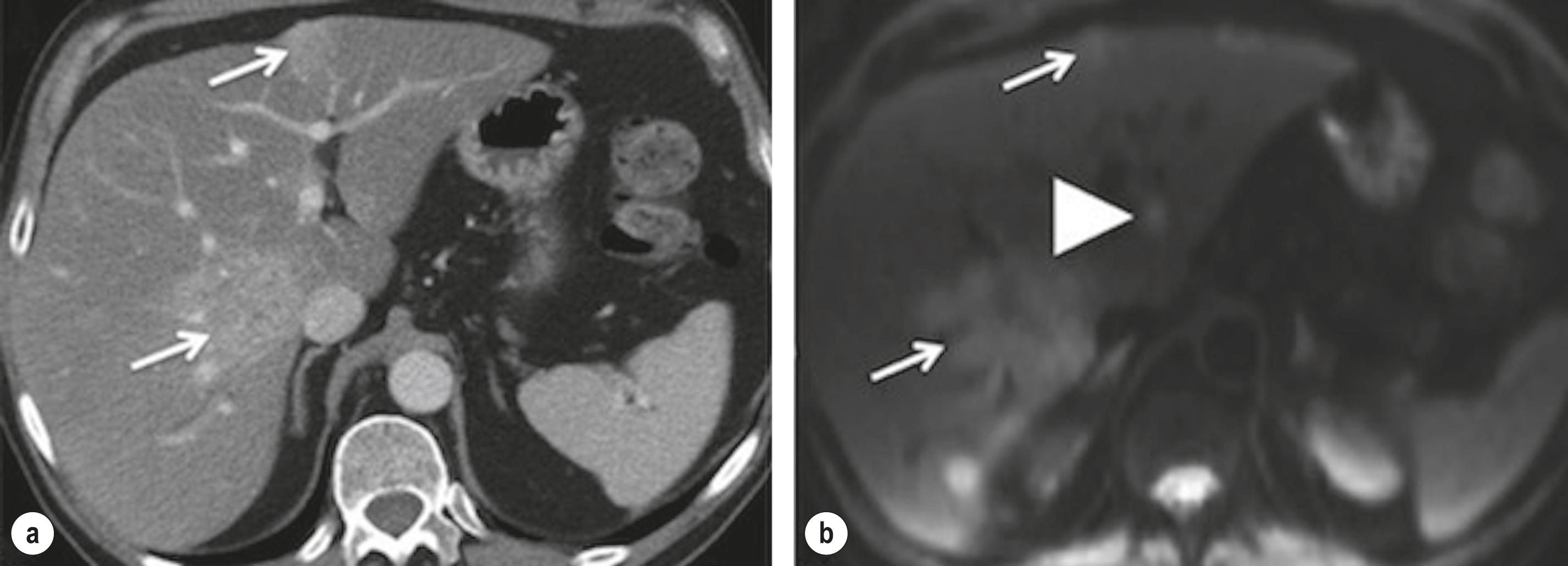
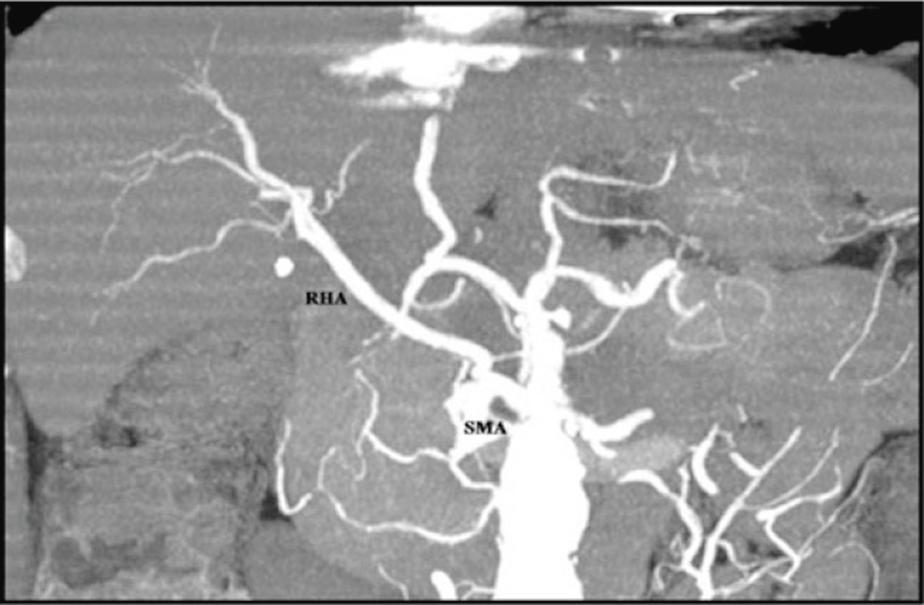
In contrast, MRI provides high-resolution assessment of the liver and can be superior to CT in detecting and characterising indeterminate small lesions ( Figs. 7.1 and 7.3 ) with sensitivity rates of 91–97%, compared with 71–73% for CT. MRI is also more accurate to differentiate benign versus malignant subcentimetre liver lesions, with a specificity of 97.5% versus 77.3% for CT. Importantly, MRI tends to be more accurate in detecting and characterising CRLM if there is underlying liver parenchymal disease. Recent advances in MRI techniques, including the introduction of tissue-specific contrast agents such as gadobenate dimeglumine and gadoxetate (Gd-EOB-DTPA; Primovist in Europe and Eovist in the USA), as well as diffusion-weighted imaging (DWI), have further enhanced the diagnostic yield of CRLM ( Figs. 7.4 and 7.5 ). An important consideration is the evaluation of CRLM among patients who have received systemic chemotherapy. Preoperative chemotherapy can affect the liver parenchyma and limit the sensitivity of cross-sectional imaging for detecting CRLM. Meta-analyses have suggested that MRI is the best modality for detecting CRLM following systemic chemotherapy.
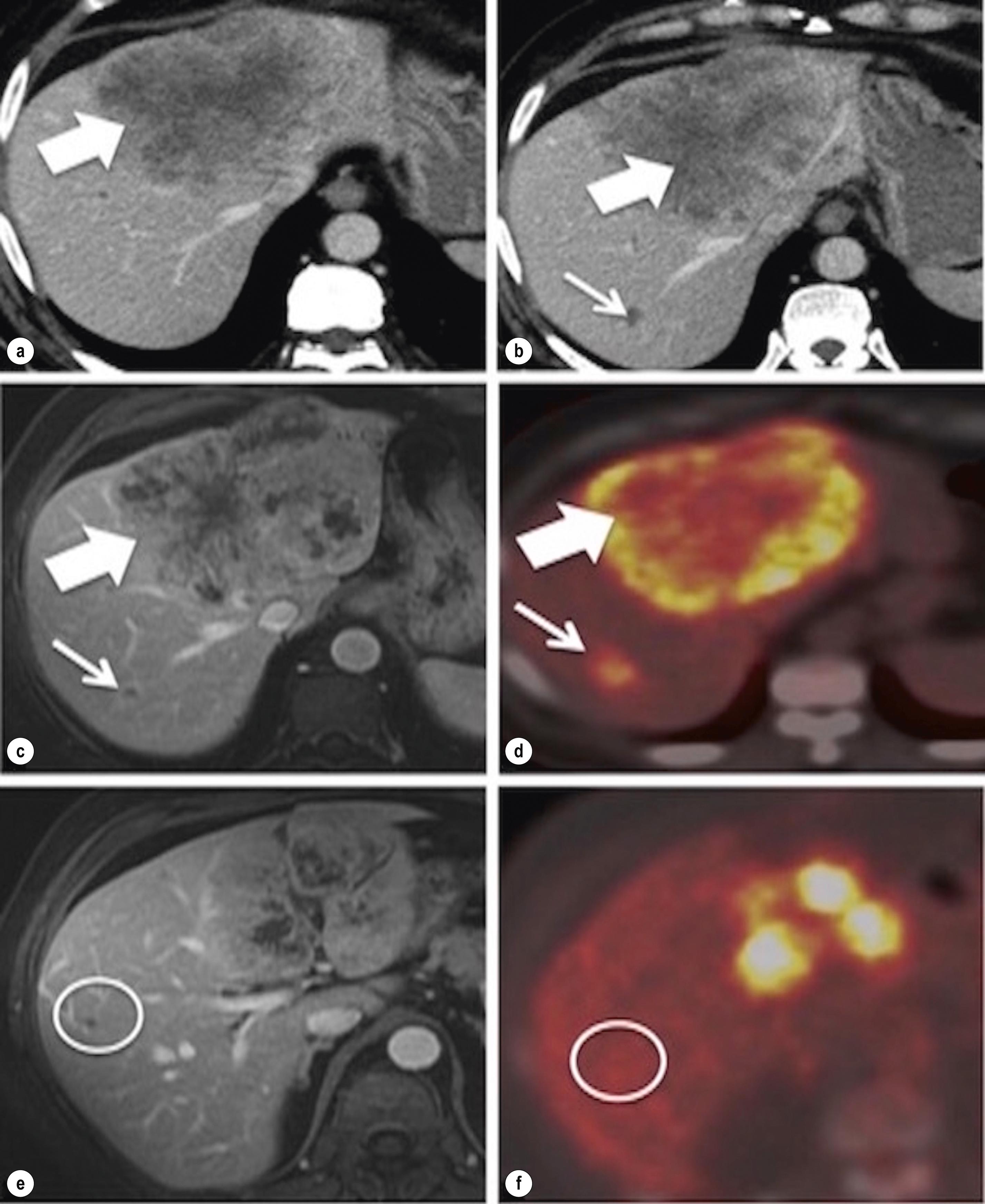
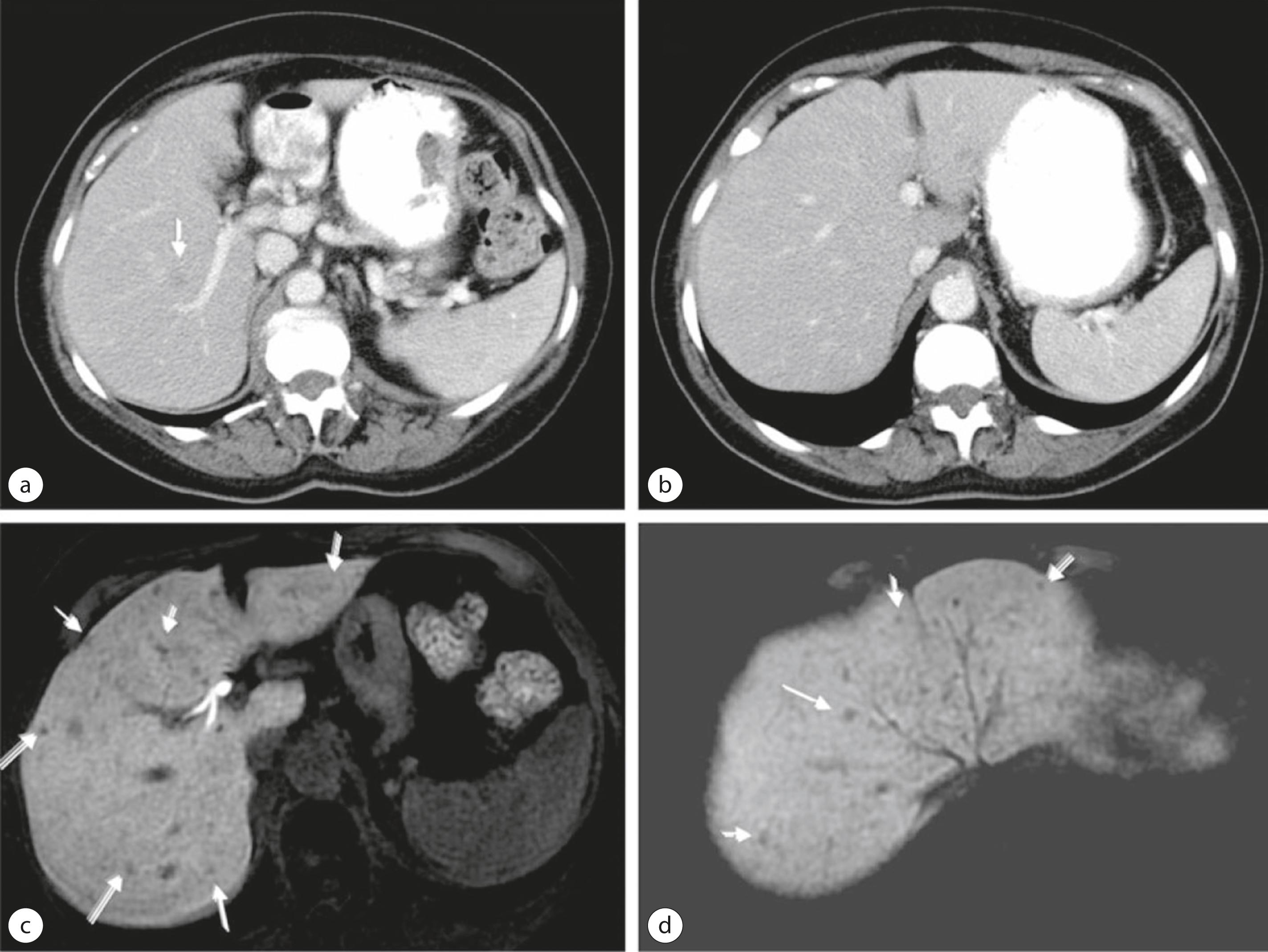
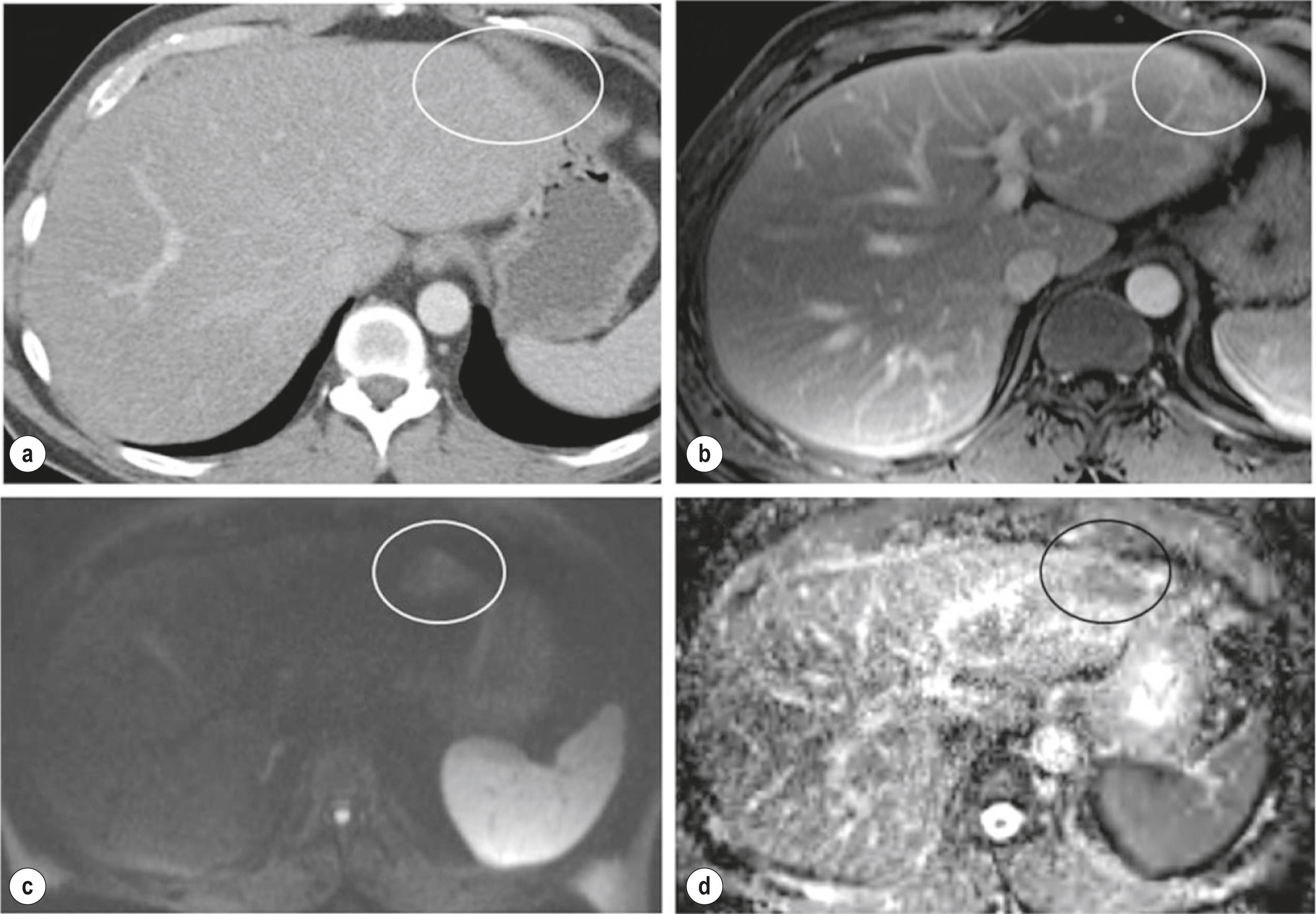
PET is another commonly used imaging modality which can supplement CT or MRI. PET utilises intravenously administered radioactive fluorodeoxyglucose (FDG) to identify metabolically active metastatic lesions. The metabolic activity of a lesion can be quantified by measuring the standardised uptake value (SUV). While the routine use of PET in CRC staging is limited due to insufficient anatomic detail, poor sensitivity of lesions smaller than 1 cm, and false-positive results in the setting of inflammation ( Fig. 7.6 ), the primary advantage of PET-CT or PET-MRI is the superior detection of extrahepatic disease ( Fig. 7.7 ) and evaluation of indeterminate lesions. PET-CT is also effective at diagnosing CRLM, with one meta-analysis highlighting a sensitivity and specificity of 74.1% and 93.9%, respectively. Whether PET should be routinely considered in the preoperative evaluation of potentially resectable CRLM is more controversial. A randomised controlled trial of 150 patients with CRLM noted that the number of futile laparotomies was reduced with the addition of preoperative FDG-PET. Thus, PET remains an important imaging modality in the evaluation of patients with possible CRLM and selection of patients for surgery.
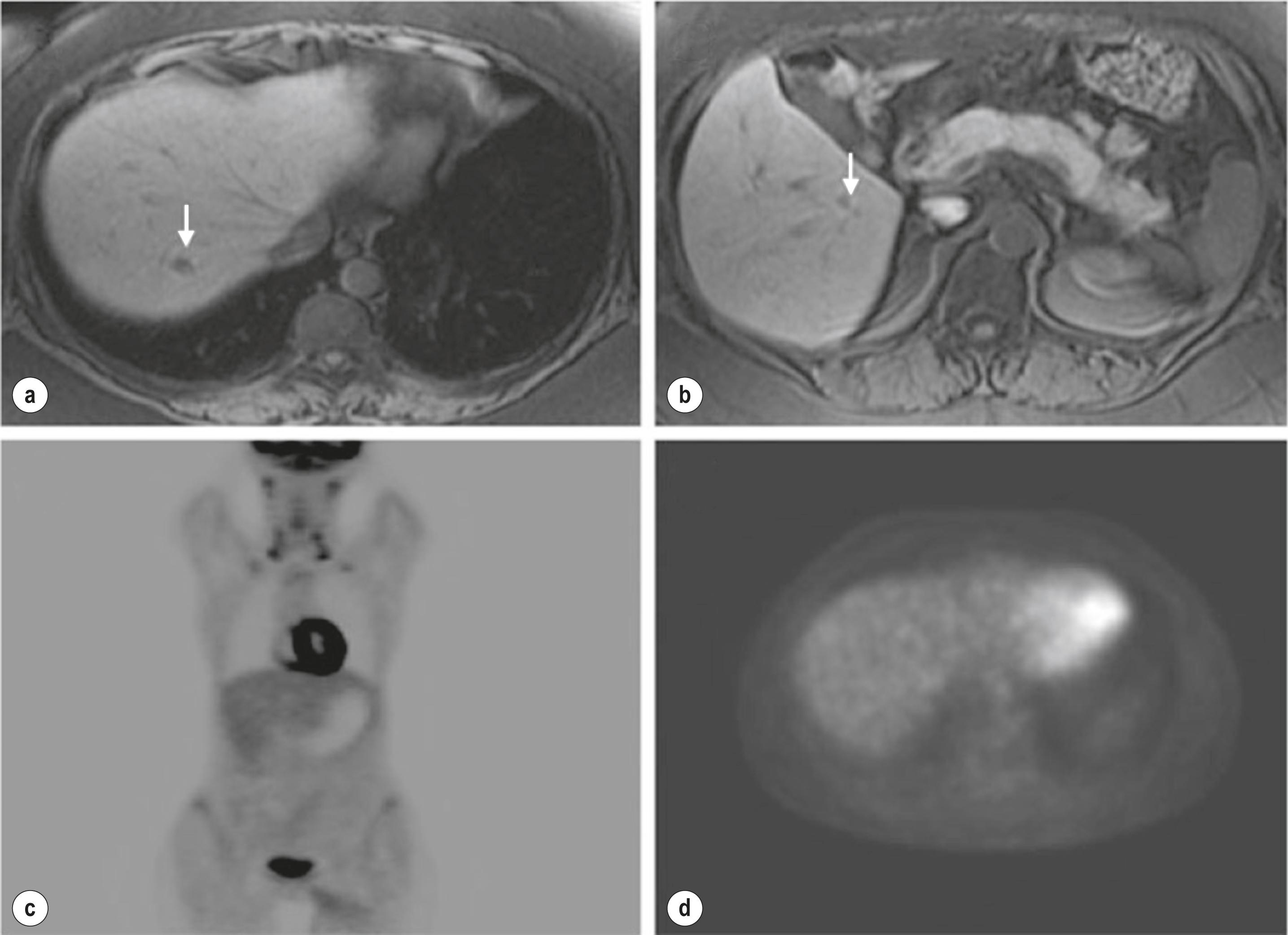
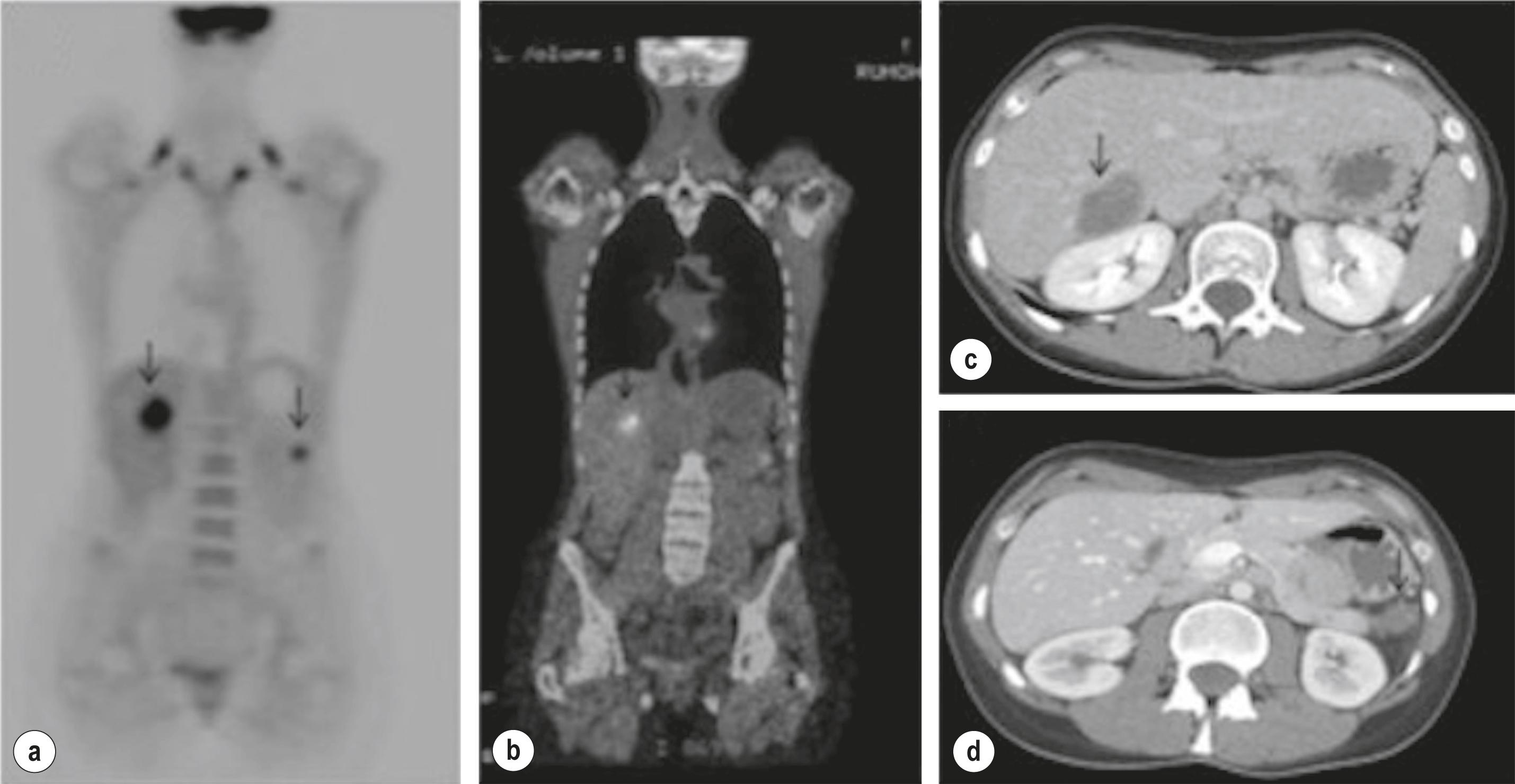
The definition of resectability has evolved considerably since Ekberg et al. in 1986 proposed that surgery for CRLM was only indicated if all of the following criteria were met: <4 metastases, no extrahepatic disease, and ability to obtain resection margins ≥ 10 mm. Though these criteria have evolved over the past four decades, there remains considerable variability in the definition of resectability among liver surgeons. Since the ability to undergo hepatic resection is one of the most important prognostic factors for patients with CRLM, the determination of resectability and candidacy for metastasectomy has significant implications. Therefore, defining which patients are candidates for surgery, as well as employing efforts to safely expand the indications for resection, are critical to extend the benefits of surgery to more patients.
![]() According to the Americas Hepato-Pancreato-Biliary Association (AHPBA) most recent expert consensus statement and also the National Comprehensive Cancer Network (NCCN) guidelines, CRLM is considered resectable as long as the tumour can be removed completely (R0 resection), the predicted future liver remnant (FLR) function is adequate to prevent postoperative liver failure, extrahepatic sites of the disease are controllable, and the primary tumour can be resected for cure.
According to the Americas Hepato-Pancreato-Biliary Association (AHPBA) most recent expert consensus statement and also the National Comprehensive Cancer Network (NCCN) guidelines, CRLM is considered resectable as long as the tumour can be removed completely (R0 resection), the predicted future liver remnant (FLR) function is adequate to prevent postoperative liver failure, extrahepatic sites of the disease are controllable, and the primary tumour can be resected for cure.
Practically, determinations of resectability are best made by a multidisciplinary team of CRC specialists. As outlined by the AHPBA consensus statement, resectability should be determined along two domains: oncologic and technical. Oncologic resectability refers to the selection of patients most likely to benefit from major liver resection based on underlying tumour biology. Relevant factors may include the burden of liver metastases, the presence of extrahepatic disease, the disease-free interval and/or the response to neoadjuvant therapy. Increasingly, given its prognostic importance, tumour mutation status may influence the determination of oncologic resectability. Technical resectability refers to the ability to perform a margin-negative resection while preserving an appropriate FLR with adequate vascular inflow and outflow and biliary drainage. Patients with normal hepatic function can safely tolerate resection with a planned FLR size of > 20%. However, in order to minimise the risk of posthepatectomy liver failure (PHLF), patients with compromised liver function (obesity, receipt of chemotherapy for greater than 12 weeks, diabetes mellitus), an FLR > 30% is advised. An FLR > 40–50% of total liver volume is necessary to minimise the risk of PHLF in patients with cirrhosis. For patients with insufficient FLR volume, several augmentation strategies can be utilised to optimise patients for liver resection.
![]() Patients who do not meet FLR requirements may benefit from additional preoperative procedures to induce hypertrophy of the FLR, such as portal vein embolisation (PVE) or associating liver partition and portal vein ligation for staged hepatectomy (ALPPS).
Patients who do not meet FLR requirements may benefit from additional preoperative procedures to induce hypertrophy of the FLR, such as portal vein embolisation (PVE) or associating liver partition and portal vein ligation for staged hepatectomy (ALPPS).
While a margin width < 1 mm is typically defined as R1 margin status, the optimal R0 margin width at the time of liver resection remains controversial. Pawlik et al. found that R1 margin status was associated with worse overall survival (OS) following liver resection, but that greater margin widths (1–4 mm, 5–9 mm, or ≥1 cm) were not associated with improved OS, recurrence risk or site of recurrence. Similarly, Sadot et al. found no benefit of margins > 1 mm but that even submillimetre margin widths were associated with improved OS compared with microscopically involved margins. On the other hand, a systematic review and meta-analysis suggested that wider surgical margins were associated with improved outcomes and margins > 1 cm should be considered if possible. Several observations suggest that the influence of margin status on outcomes more likely represents a biological effect. First, patients with RAS mutations are more likely to have positive margins. Second, the prognostic significance of R1 margin status is mitigated among patients with a significant radiographic or pathologic response to neoadjuvant therapy. Finally, conversion of an R1 margin to R0 by intraoperative re-resection has not been associated with improved outcomes. Thus, while microscopically negative margins ≥ 1 mm remain the objective of any resection for CRLM, the direct impact of margin status on patient outcomes may be less impactful than other biological factors ( Fig. 7.8 ).
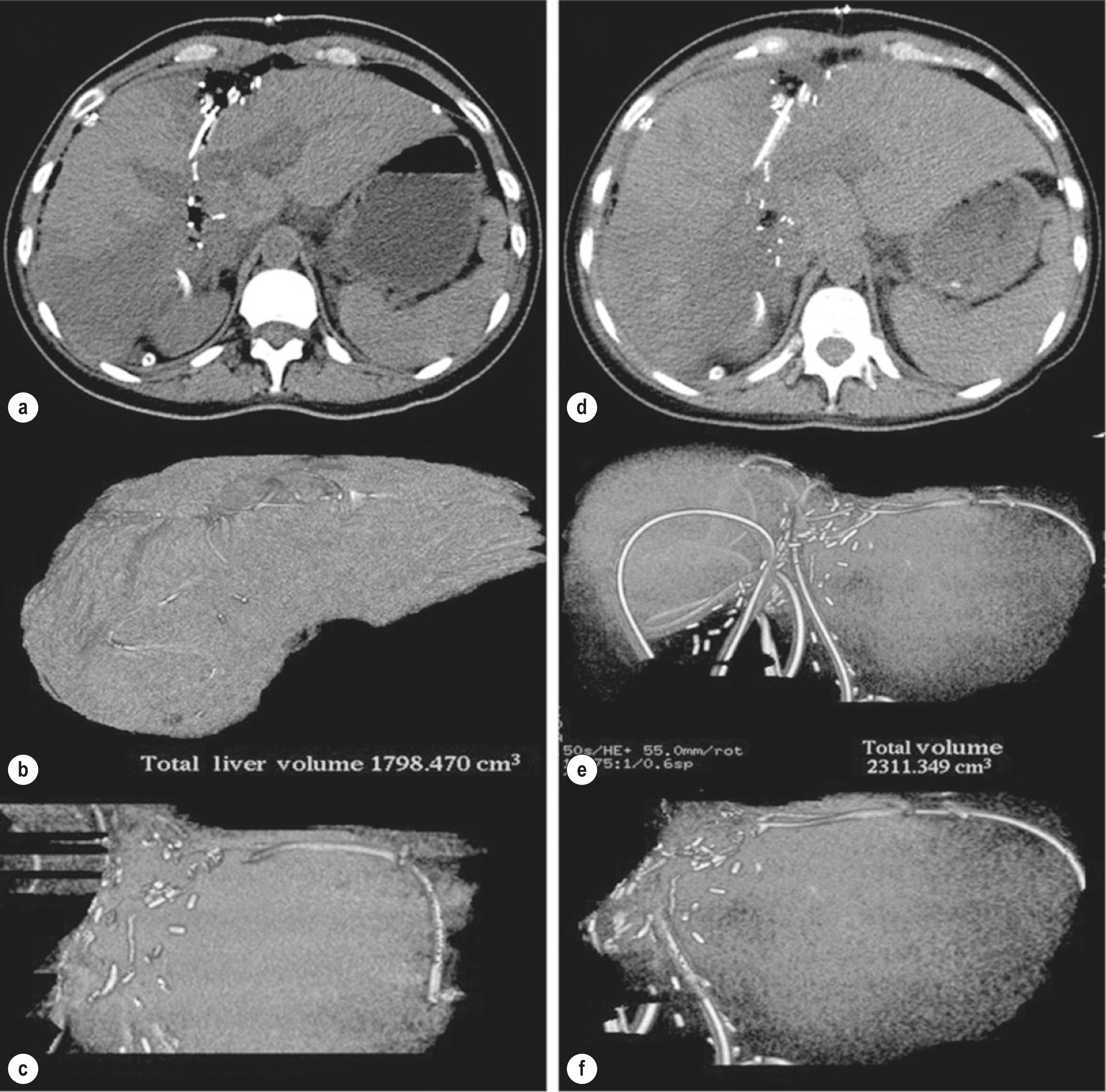
The objective of parenchymal-sparing hepatectomy (PSH) is to maintain oncologic principles of margin-negative resection while maximising the remaining liver remnant. In practice, PSH usually emphasises resection of one or more liver segments rather than an entire hemiliver. While anatomic resections, such as segmentectomy or sectionectomy, are often used in parenchymal-sparing approaches, these procedures can also often be achieved by more limited non-anatomic resections, occasionally termed wedge resections. PSH is associated with not only reduced incidence of PHLF but also salvageability in the case of liver recurrence. , Systematic reviews of PSH are suggestive of perioperative benefits with no difference in long-term outcomes. On the other hand, recent literature has called into question the role of PSH for patients with KRAS -mutant CRLM, although this remains controversial.
![]() Surgeons should aim for microscopic negative margins > 1 mm. Parenchymal-sparing approaches are acceptable when feasible and may be associated with improved short-term outcomes and salvageability in the case of hepatic recurrence.
Surgeons should aim for microscopic negative margins > 1 mm. Parenchymal-sparing approaches are acceptable when feasible and may be associated with improved short-term outcomes and salvageability in the case of hepatic recurrence.
The lungs, intra-abdominal lymph nodes and peritoneum are the most common sites of CRC metastases following the liver. The presence of extrahepatic metastases has been associated with poor outcomes and traditionally considered a contraindication for hepatic resection. However, with recent advances in surgical techniques and systemic medical treatment, hepatic resection can be considered in patients with extrahepatic disease, particularly those individuals amenable to local treatment (e.g. resection, ablation or radiation). For example, Shah et al. demonstrated that an aggressive multidisciplinary approach to treat combined lung and liver metastases resulted in prolonged OS. Nevertheless, consideration can be given to surgical resection of CRLM even for selected patients with limited unresectable extrahepatic metastases that can be controlled with maintenance systemic therapy. For example, Mise et al. reported worse OS among patients who underwent resection of CRLM alone than patients who underwent resection of liver and lung metastases, but better than a similar cohort of patients who received chemotherapy alone. Patients with extrahepatic disease who are being considered for liver resection should be managed in a multidisciplinary setting and generally should be treated with preoperative therapy to help define tumour biology.
Technical advances in minimally invasive surgery have expanded the indications for laparoscopic and robotic liver resections. Indeed, over the past several decades, the indications for minimally invasive surgery and proposed management guidelines have been generated at several international consensus conferences. Regarding resection of CRLM, the OSLO-COMET trial randomised patients with resectable CRLM to either open or laparoscopic PSH. Laparoscopic liver resection resulted in improved short-term outcomes with no differences in margin status or OS. , Subset analysis of tumours in more technically challenging posterosuperior segments demonstrated similar results. , Systematic reviews and consensus guidelines support the use of laparoscopic approaches to resection of CRLM. , Robotic approaches to surgery for CRLM appear to result in similar short- and long-term outcomes compared with laparoscopic liver resection.
The management of bilobar CRLM has undergone significant advances in recent years. Extending the benefits of surgery to patients with advanced bilobar CRLM represents a prime opportunity to improve outcomes of patients with metastatic CRC. The choice of surgical strategy for patients with bilateral CRLM depends on the burden and location of the tumour. A one-stage approach with multiple PSHs is a safe and effective technique in management of small and favourably positioned bilateral CRLM. When CRLMs in the right hemiliver are peripheral but the central in the left hemiliver, then a formal left hepatectomy may be combined with PSHs of the right-sided peripheral lesions. Alternatively, ablation of a central left tumour along with PSHs of the right tumours could be performed. Either approach can be performed in a single-stage fashion. In general, combination resection-ablation is safe and may be associated with decreased blood loss, shorter hospital stay and less morbidity compared with aggressive resectional approaches.
For bilobar CRLM where extended right hepatectomy is required, careful attention to the FLR is necessary. In general, ablation/resection of metastases in the left liver remnant should be avoided.
Patients with inadequate FLR may be considered for two-stage hepatectomy (TSH). In the first stage, the FLR is cleared of metastatic disease followed by PVE. A second curative-intent stage of the operation is performed after hypertrophy of the contralateral liver when there has been adequate increase of the FLR volume. The long-term survival of patients who complete both stages is comparable to patients with more limited disease treated by a conventional single‐stage strategy. An alternative to TSH is ALPPS. In this two stage approach, a right portal vein ligation is first combined with parenchymal transection and clearance of the FLR of metastases. The second stage is performed during the same hospital admission 1–2 weeks later and involves completion hemihepatectomy. ALPPS is associated with high morbidity and mortality, but accumulating evidence suggests it is a reasonable option for well-selected healthy patients with bilobar CRLM.
Become a Clinical Tree membership for Full access and enjoy Unlimited articles
If you are a member. Log in here